NAPO 2010 Conference Expo Recap #2: Innovations in Office Paper Organization
Last week, Paper Doll reviewed some of the products at the NAPO 2010 Conference Expo designed to help you gather and box up your important papers for organized safekeeping. Today, we’re going to review some solutions specifically for filing, whether for your business or home office.
It’s not uncommon for major dichotomies (PC vs. Mac, Dymo vs. Brother) to spring up in the organizing world, just as we see in the real world (Ford vs. Chevy, Yankees vs. well, everybody else). It might seem that there are no two adversaries looming as large as Smead vs. Esselte’s Pendaflex. For example, in last year’s post-NAPO Conference Expo recap, Smead’s Tuff Hanging Folders went head to head with Pendaflex’s Hang Tuff™ (now Sure Hook™) Hanging Folders. However, in the words of the Arbiter in the Opening Ceremonies theme from the musical Chess:
This is not the start of World War III
No political ploys
I think both your constitutions are terrific.
So now you know — be good boys.
We professional organizers love Smead and Pendaflex’s paper management products equally, and we just want them to keep pumping out ever more fabulous product innovations.

No More Tears (boo hoo)…Or Tearing (rrrrrrip!)
The first thing that caught my attention at Smead’s booth was innovative less for what it does than for what it doesn’t do — cause owies.
Files with fasteners keep papers from becoming separated from the folder or associated papers, and maintain proper chronological order for easy reference, but they’re a pain. Paper cuts are the first danger we face when organizing papers, but if your office uses folders with fasteners, common in legal, medical and accounting offices, you know the pain that can sometimes be inflicted by those twist-ties on steroids. They’re cold, sharp and they poke at your skin. They tear the paper, become crinkly after being bent multiple times to add new papers, and can scratch your desktop.
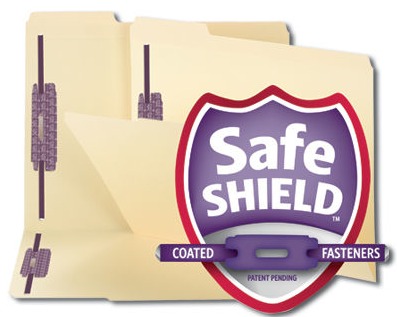
Smead’s coated SafeSHIELD™ Coated Fasteners are being billed as the “feel-good solution for your documents and fingers”. The metal strip fasteners are covered in a smooth, leathery sort of coating to prevent scratching skin and surfaces or tearing papers. I tested a sample, bending and twisting, and though I’m sure the metal strips were crinkly after my abuse, the SafeSHIELD coating kept the fastener smooth and my fingers safe. SafeSHIELD™ fasteners now appear on fastener folders with dividers, end-tab fastener folders with pockets, and various other legal and letter fastener folders.
Organized People Like a Firm Handshake
At first glance, the Easy Grip Pocket looks like every other heavy-duty redrope (reddish-brown, to the rest of us) accordion-edged, Tyvek-enhanced pocket for maintaining thick stacks of papers, reference material or directories. Innovative? I was dubious when Smead’s Julie Hicks pressed me to test it out at the Expo booth.
A regular pocket folder and the Easy Grip stood side-by-side, filled to almost bursting with the same heavy load of documents (and possibly some small bricks, from the feel of it). I reached out with one hand, adjusted my “I’d like a hamburger THIS big” motion to fit the expanse of the opening and attempted to lift it. Because the smooth paper of the pocket folder slipped in my fingers, I had to tighten my grip and put forth more effort with my hair dryer muscle (AKA: biceps).
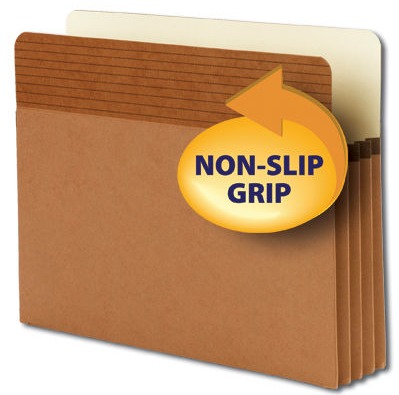
However, when I repeated the process with the Easy Grip, I was delighted that the addition of a non-slip, faintly rubbery, “grippy” texture on the upper portion of the pocket meant that I neither had to squeeze tightly with my hand muscles or strain my thumb or wrist. It’s not exactly magic, but we all know that every little annoyance in our office makes us more likely to become distracted, and less inspired to organize our files.
Easy Grip folders come in letter and legal sizes for 1 3/4″, 3 1/2″, or 5 1/4″ expansion.
The Roar of the Crowd
Stadium-seating movie theaters have become popular in recent years. They’re beloved because you no longer have to fear that the point guard for the high school basketball team will be sitting in front of you at the movies. The graduated, tiered seating makes sure that nothing obscures your view of the screen.
Smead’s Stadium File does for desktop filing what stadium seating does for movie patrons. Too often, our file systems start out methodically organized, with successive folder tabs running left, center, right, left, center, right — until the day you need to add a new folder and end up with a left-tab folder behind another left-tab folder. The more files you have, and the more crowded the are, the less easily you’ll spot the folder you need at a glance, and the more likely you’ll have to let your fingers do the hiking, slogging through the paper equivalent of muddy terrain.
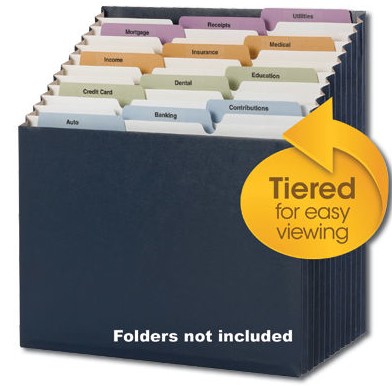
The Stadium File has twelve tiered pockets, holds 900+ sheets of paper, and includes labels for A-Z, Jan-Dec, 1-31, household subject categories (like Auto, Banking, Insurance, etc.) and blanks for customization. It’s accordion-style with fully-lined Tyvek gussets to keep it sturdy, and the two I’ve tested (at the Expo and with a client) managed to stay upright no matter how many papers or files were inserted.
![]()
Me, Myself and I…Organize
Pendaflex’s big 2010 innovation is a new portable filing system, the I*Organize Binder, designed to give the user complete customization control with mix and match filing elements. I’ll admit, I didn’t quite get the appeal at first, as it seems too minimalist for professional use, but after a few hands-on experiments, I see this is no mere Trapper-Keeper!
The system includes two aspects, the binder and the filing tools. The binders, instead of using pockets or rings, rely on a nifty system of “channels” into which other filing elements can easily slide in or out and then click into place. No hole-punching required–just unlock, align the spine of the tools with channel system, slide and lock!
The choice of three binders includes:
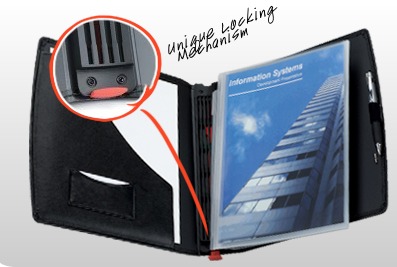
–The Presentation Binder comes in a leatherette finish and has four channels for creating classy presentations.
–The Storage Binder is constructed of durable poly and has eight channels for maximum storage potential.
–The Essential Binder is made of a flexibly poly and has four channels, with a slim design created to fit easily in a backpack.
The filing tools include the following options, all of which slide vertically into a channel on the binder’s interior spine:
Clipboard–for taking notes or following itineraries
Project Pocket–segments papers with three dividers and write/erase tabs
Twin Pocket Folder–allows for protected display of horizontal 11″ x 17″ documents
Envelope–with elastic closure for receipts, business cards and easily lost items
Secure File Folder–has large storage capacity
Display Book–five clear pockets (10 page display)
Media File–holds CDs, DVDs, flash drives and memory cards
Wave Pocket–holds up to 30 easily accessed pages behind a die-cut wave pattern that exposes the upper right portions. 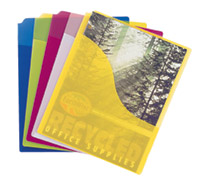
The spine of each filing tool has fold-out channel strips that tuck away when not used with the system’s binder.
Ice Cold Milk and an Oreo Cookie–It’s All About the Double-Stuff!
When organizing paper (a topic obviously close to Paper Doll‘s heart), it’s important to strike a balance and have categories that are neither too broad nor all-encompassing. It does no good for productivity to have a folder that never carries more than one or two sheets, nor another that carries the weight of the world in triplicate.
Sometimes, however, one category of paperwork requires a thick stack of papers and cannot easily be divided into multiple folders based on sub-categories or chronology. In the hanging folder world, there have long been box-bottom folders, sturdy hanging folders designed to hold directories or other heavy-duty contents. With regard to interior file folders, whether manila or colorful, their bottoms (if you’ll pardon the expression) have seen little innovation over the years.
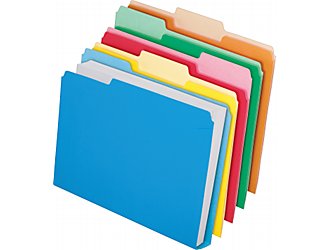
Just about every file folder, whether high-end with paper-cut prevention and fancy design, or overpriced, off-brand packs of five from the drugstore, comes with those two or three ridges near the crease. When a file folder’s girth causes papers to shift upward and threatens to obscure the folder’s label, you can widen a folder’s base by folding down some or all of the ridges, expanding the typical folder’s bottom edge to about three-quarters of an inch.
But what if you have more papers than that? This is when you might need Pendaflex Double-Stuff File Folders. Each high-capacity file folder holds over 250 sheets of paper and is made of sturdy 11 pt. acid-free paper. Unlike how regular folders have the two expandable ridges on the front, such that expansion causes the front of the folder to have a much lower profile than the rear, the Double-Stuff folders have one ridge, each, on the front and rear of the folder, allowing the base to expand up to 1 1/2 inches without sacrificing frontal coverage.
Caution: Wide Load
When asked what products they should purchase in advance of an office organizing session, most professional organizers will make sure their new clients have a robust collection of hanging folders and interior file folders. We usually caution clients to make sure they buy 1/3-cut, or three-tab, file folders. The typical alternative is 1/5 cut, or five-tab, file folders, but five-tabs simply lack enough space to adequately label most file folders with pertinent details.
Certainly, we advise clients to only label folders with pertinent, non-duplicated, specific information. But what happens when the file label needs to be longer than even a 1/3-cut folder can manage? And what happens when a client is averse to abbreviating a name or project title?
There are two common alternatives organizers will employ. The first is to reduce the print size on our labelmakers (or try to hand-print very neat, very small labels). This is unsatisfactory to many clients, as the larger type-face of the printed labels is often a major motivator to stick with the organizing process, and clients with advancing age and/or declining vision find the smaller labels either unreadable or unmotivating.
The second alternative is to carry the label down to a second line. Although this allows for detailed file labeling, if the printed label is large enough to be read clearly, the second line will likely be obscured once papers are put into the folders.
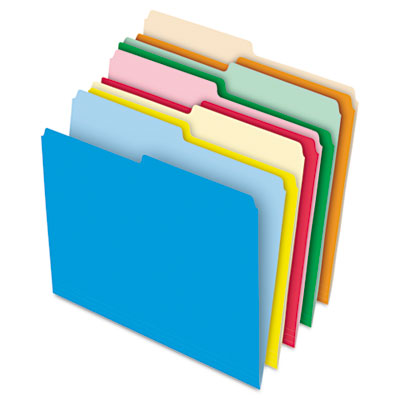
This is where Pendaflex’s Stretch Tab File Folders come to the rescue — the tabs are 50% longer than 1/3 cut tables to increase the visual labeling area. As the colors are matched to traditional multicolor Pendaflex files, the Stretch Tab File Folders seamlessly merge and integrate with the folders already being used. So, if you’re trying to create a folder for Anna Banana Fe-Fi-Fo-Fanna’s Annual Family Reunion, the stretch tabs will work like a stretch limousine, to get you where you want to go — in style.
Both Smead and Pendaflex courted professional organizers with many more wares than can be mentioned in one post. If paper were poker, I could see you Pendaflex’s anti-microbial file folders and raise you Smead’s See File and All-In-One Tax Organizer. If we were ready to rumble, we could have a grudge match of Smead’s Fastab folders and Easy Slide hanging folder tabs against Pendaflex’s Ready-Tab file folders and hanging folder tabs. But the first rule of Fight Club is “Don’t talk about Fight Club”.
I’ll be back next week with a review of some of the digital information solutions from the NAPO Expo.




Follow Me